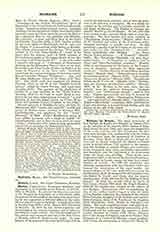

Huelgas de Burgos. —The royal monastery of Las Huelgas de Burgos was founded by Alfonso VIII at the instance of his consort, Dona Leonor of England, about the year 1180, and, upon the completion of the work necessary for their installation the first nuns were brought to it, conformably with the wishes of its founders, from the monastery of Tulebras in Navarre. Dona Misol, or Marla Sol, was its first abbess, and to her was addressed the charter of foundation, in which Alfonso VIII granted to the community the lordship of sundry villages and territories, entire exemption from taxes, numberless immunities and franchises, and the enjoyment of its possessions under the king’s own privilege. These grants were augmented until, at the end of the fourteenth century, no feudal lord in Castile, except the king, had a larger number of vassals. In 1199 the monastery was solemnly incorporated with the Cistercian Order and became the burial-place of the royal family; the general chapter of the order made this monastery the motherhouse of all the monasteries of Cistercian nuns established in Castile and Leon, and the annual meeting-place of the abbesses for the holding of their chapter. In 1212, two months before the battle of Las Navas, Alfonso VIII made the King’s Hospital, with all its dependencies, subject to the Abbess of Las Huelgas. Immediately after its foundation, la-dies of the noblest families began to take the habit at Las Huelgas, following the example of the Infanta Dona Costanza, daughter of the founder, and another Dona Costanza, sister of St. Ferdinand, his daughter Dona Berenguela, Dona Blanca of Portugal, and others. The most auspicious events took place here, such, for example, as the knightly consecration of St. Ferdinand and his successors, the nuptials of Dona Leonor (Eleanor of Castile) with Prince Edward, heir to the throne of England, and of the Infante Don Fernando de la Cerda with Blanche, second daughter of St. Louis, the coronations of Alfonso XI, Henry II, and John I, and the proclamation of the coming of age of Henry III. Here, too, were buried Alfonso VII, Sancho III, and many infantes and infantas, and the monastery was often visited by, and received gifts from, the kings and queens.
The characteristic peculiarity, however, which made this monastery famous was its abbess’s exercise, for some centuries, of the vere nullius ecclesiastical jurisdiction, until, in 1873, all exempt jurisdictions were abolished by the Bull “Quae diversa”. The abbesses of Huelgas, in consequence of this privilege, issued faculties to hear confessions, to say Mass, and to preach; they nominated parish priests, appointed chaplains, granted letters dimissory, took cognizance of first instance in all causes, ecclesiastical, criminal, and relating to benefices, imposed censures through their ecclesiastical judges, confirmed the abbesses of their subject houses, drew up constitutions, visited monasteries—in a word, they possessed a full ecclesiastical jurisdiction. Don Amancio Rodriguez, who has made a special study of Huelgas, assures us that there never was any pontifical Bull in which these rights were specifically granted; but there certainly was the tacit consent of the popes, without which the practical exercise of the jurisdiction would never have been possible under the eyes of the bishops of Burgos and the papal nuncio. Besides, not only the nuncio, but the Roman Curia confirmed the abbess’s decisions on appeal and rejected appeals unduly made, in order that the abbess might deal with the cases as in first instance. The origin of this privilege, then, must be sought in the king’s intervention in the affairs of the Church, in the protection accorded by the abbots of Citeaux and by the Roman pontiffs, and in the fact that several infantas were nuns in the monastery. The royal foundation fell somewhat into decay in the time of Charles I, but afterwards recovered some of its ancient splendor, chiefly in the beginning of the seventeenth century, when Dona Ana de Austria, natural daughter of Don John of Austria, brother of Philip II, became its abbess in perpetuity. From the time of the secularization of church property (Leyes de Desamortizacion) its support and conservation has been the care of the sovereigns of Spain.
RAMON RUIZ AMADO

